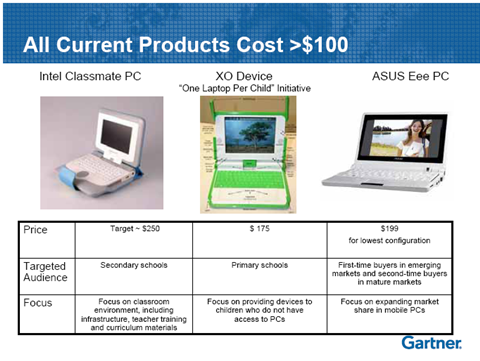Gartner: $100 laptop still too expensive for the emerging markets

The concept of a $100 PC has been held as the Holy Grail for computing in emerging markets, but the reality is vastly different, according to Gartner. Bottom line: $100 for a PC is still the monthly salary of a teacher in Russia and two to three months salary in India. It's too expensive.
"The $100 PC is still quite expensive for the emerging markets. And that's just the hardware. There are other implementation costs," says Annette Jump, an analyst at Gartner who has studied ultra-low cost PCs (ULPCs) like the One Laptop Per Child XO laptop and Intel's Classmate.
The idea of a $100 laptop makes sense to improve penetration to drive economic development, says Jump, speaking at Gartner's Emerging Technologies Conference Monday in Las Vegas. The rub: The PC is still in the early stages and the $100 price tag is not possible for the next three years.
Some key stats:
- The U.S. has 812 PCs per 1,000 people.
- The U.K. has 699.
- India has 28 per 1,000.
- China has 93 per 1,000.
Bridging that gap between mature and emerging markets will require new innovation to bring prices down. Here's the breakdown of the leading players:
Jump wasn't totally poo-poohing the idea of emerging market PCs, but questions abound. Consider the following:
It's unclear whether the hardware specs are good enough to deliver a good user experience.
- How much will it cost? "$100 is still the goal," says Jump.
- What OS will these devices run?
- Who will buy it?
- How will it connect to the Internet? "In Africa, a one month subscription to the Internet can run you $200," explains Jump, adding access is a hurdle even if the device is free.
Given those economics the $100 laptop has to approach free to really make a big impact. Jump's prognosis wasn't good. She estimated that it's unlikely that vendors can realistically approach $100 in the next three years. Lower CPU and motherboard, memory and LCD costs may help, but other costs--packaging for instance--aren't likely to budge. Jump already assumes software costs will be nil.
See Christopher's Dawson review of Intel's second generation Classmates.
And my XO laptop lessons learned.
Jump also floats an interesting idea:While it is important for the prices to continue to come down, we need to keep in mind that the actual devices need to be workable for the purpose that they are created: education and access to the Internet. Fixation on a $100 mark is unnecessary and could distract companies from focusing on other issues around these devices.
Jump adds that it may make sense to focus on delivering PCs that operate in native languages.
If that's the case, the story about low-costs PCs shifts from costs to subsidies. Will governments and charitable organizations fund a PC that runs for $175? Will they fund the infrastructure needed to go with these low-cost PCs?
Gartner's presentation notes:
Gartner believes that government support and funding as well as pricing are the two most important factors that will determine the success or failure of ULPCs. The other factors that will determine the success or failure of ULPCs are Microsoft support, Intel and AMD support, software and training in a local language and support costs.
Here's a look at Gartner's scenario forecast:
What do you think? My take: We need to get more implementations of these low-cost laptops and lessons learned. For instance, Gartner notes that an XO deployment initially lacked proper planning and training remains an issue for all players.
Another thought: It's possible that the laptop is the long form factor. Would mobile Internet devices be a better choice?
